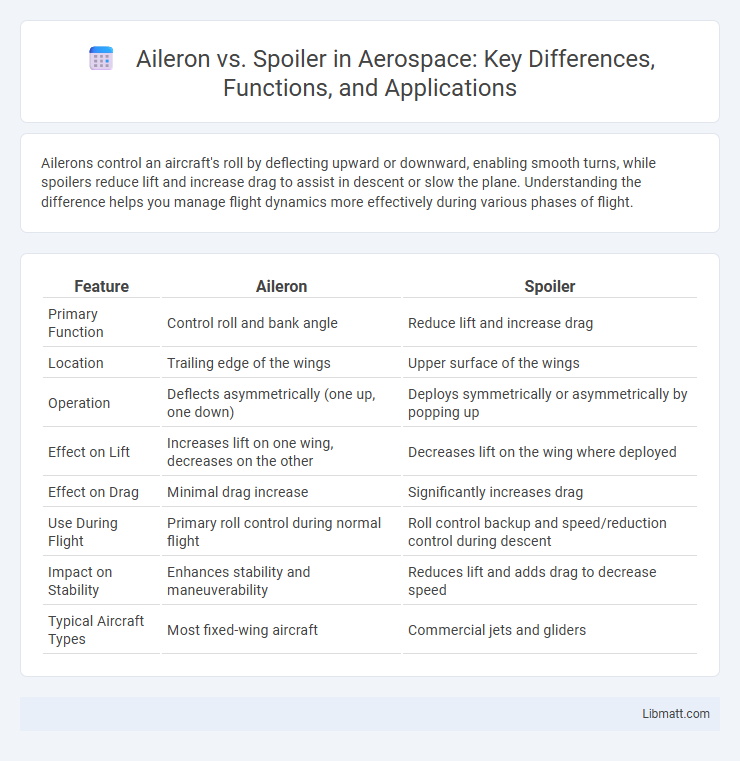Ailerons control an aircraft's roll by deflecting upward or downward, enabling smooth turns, while spoilers reduce lift and increase drag to assist in descent or slow the plane. Understanding the difference helps you manage flight dynamics more effectively during various phases of flight.
Table of Comparison
| Feature | Aileron | Spoiler |
|---|---|---|
| Primary Function | Control roll and bank angle | Reduce lift and increase drag |
| Location | Trailing edge of the wings | Upper surface of the wings |
| Operation | Deflects asymmetrically (one up, one down) | Deploys symmetrically or asymmetrically by popping up |
| Effect on Lift | Increases lift on one wing, decreases on the other | Decreases lift on the wing where deployed |
| Effect on Drag | Minimal drag increase | Significantly increases drag |
| Use During Flight | Primary roll control during normal flight | Roll control backup and speed/reduction control during descent |
| Impact on Stability | Enhances stability and maneuverability | Reduces lift and adds drag to decrease speed |
| Typical Aircraft Types | Most fixed-wing aircraft | Commercial jets and gliders |
Introduction to Ailerons and Spoilers
Ailerons and spoilers are essential aerodynamic control surfaces on aircraft that manage flight stability and maneuverability. Ailerons are hinged flight control surfaces located on the trailing edge of the wings, primarily responsible for controlling roll by increasing or decreasing lift on each wing. Spoilers, found on the upper wing surfaces, disrupt airflow to reduce lift and increase drag, aiding in descent and speed control during landing or abrupt maneuvering.
Basic Functions of Ailerons
Ailerons primarily control the aircraft's roll by increasing lift on one wing while decreasing it on the other, enabling smooth turns and banked maneuvers. Situated near the outer trailing edge of each wing, ailerons respond to pilot inputs to adjust the aircraft's lateral axis. Understanding aileron function is crucial for managing your aircraft's stability and direction during flight.
Key Purposes of Spoilers
Spoilers primarily serve to disrupt airflow over the wing, reducing lift and increasing drag to help slow the aircraft during descent and landing. They also aid in roll control by decreasing lift on one wing, complementing the ailerons for precise maneuvering. This dual function enhances stability and control, especially during approach and touchdown phases.
Structural Differences Between Ailerons and Spoilers
Ailerons are hinged control surfaces located on the trailing edge of an aircraft's wings, designed to control roll by moving in opposite directions to each other. Spoilers are flat panels on the upper wing surface that extend upward to disrupt airflow and reduce lift, primarily used for roll control and descent rate management. Your understanding of these structural differences highlights that ailerons manipulate airflow through differential deflection, while spoilers rely on lift reduction by surface disruption.
How Ailerons Control Roll Movements
Ailerons control roll movements by adjusting the aircraft's wing lift asymmetrically, increasing lift on one wing while decreasing it on the opposite wing. This differential lift causes the aircraft to rotate around its longitudinal axis, enabling controlled banking and turning. Unlike spoilers that reduce lift to assist in descent or roll, ailerons provide the primary mechanism for precise roll control during flight.
Spoilers and Their Role in Reducing Lift
Spoilers play a critical role in reducing lift by disrupting the airflow over the wing, causing a decrease in the wing's overall aerodynamic efficiency. Unlike ailerons that primarily control roll, spoilers deploy to increase drag and decrease lift, improving aircraft descent and braking performance during landing. Your understanding of spoilers helps optimize flight control techniques by managing lift reduction efficiently.
Operational Scenarios: Ailerons vs. Spoilers
Ailerons primarily operate during normal flight to control roll by increasing lift on one wing while decreasing it on the other, enabling smooth turns. Spoilers deploy mainly during descent and landing phases to reduce lift and increase drag, aiding in rapid altitude loss and ground braking. Military and commercial aircraft may also use spoilers differentially for roll control in high-speed or emergency scenarios where aileron effectiveness is reduced.
Effects on Aircraft Handling and Stability
Ailerons primarily control the roll of the aircraft by increasing lift on one wing while decreasing it on the opposite wing, enhancing maneuverability. Spoilers reduce lift and increase drag on a wing, aiding in descent and roll control but can decrease overall stability when deployed asymmetrically. Understanding the distinct effects of your aircraft's ailerons and spoilers is essential for maintaining optimal handling and safety during flight.
Maintenance Considerations for Ailerons and Spoilers
Maintenance considerations for ailerons and spoilers differ significantly due to their distinct mechanical designs and operational roles. Ailerons require regular inspections of hinge points, control linkages, and surface integrity to prevent aerodynamic imbalances and ensure precise roll control. Spoilers demand frequent checks on hydraulic actuators, panel seals, and deployment mechanisms to maintain their effectiveness in drag increase and lift reduction during flight phases such as descent and landing.
Choosing the Right Surface: Ailerons or Spoilers?
Selecting the appropriate control surface depends on the aircraft's design and intended flight function. Ailerons are primarily used for roll control by altering lift on the wings, providing precise maneuverability during flight. Spoilers reduce lift and increase drag, making them ideal for descent management and roll assistance, especially on large commercial jets where rapid lift dumping is necessary.
Aileron vs Spoiler Infographic

 libmatt.com
libmatt.com